Shrubs add structure and depth to the landscape as substantial mid-story forms that function as specimen plantings, backdrops to lower profile plants, and transitional armature between ground and canopy layers.
There are also compact varieties suitable for small spaces and container growing.
It’s easy to overlook the bushes in our yards as nondescript blobs that we garden around.
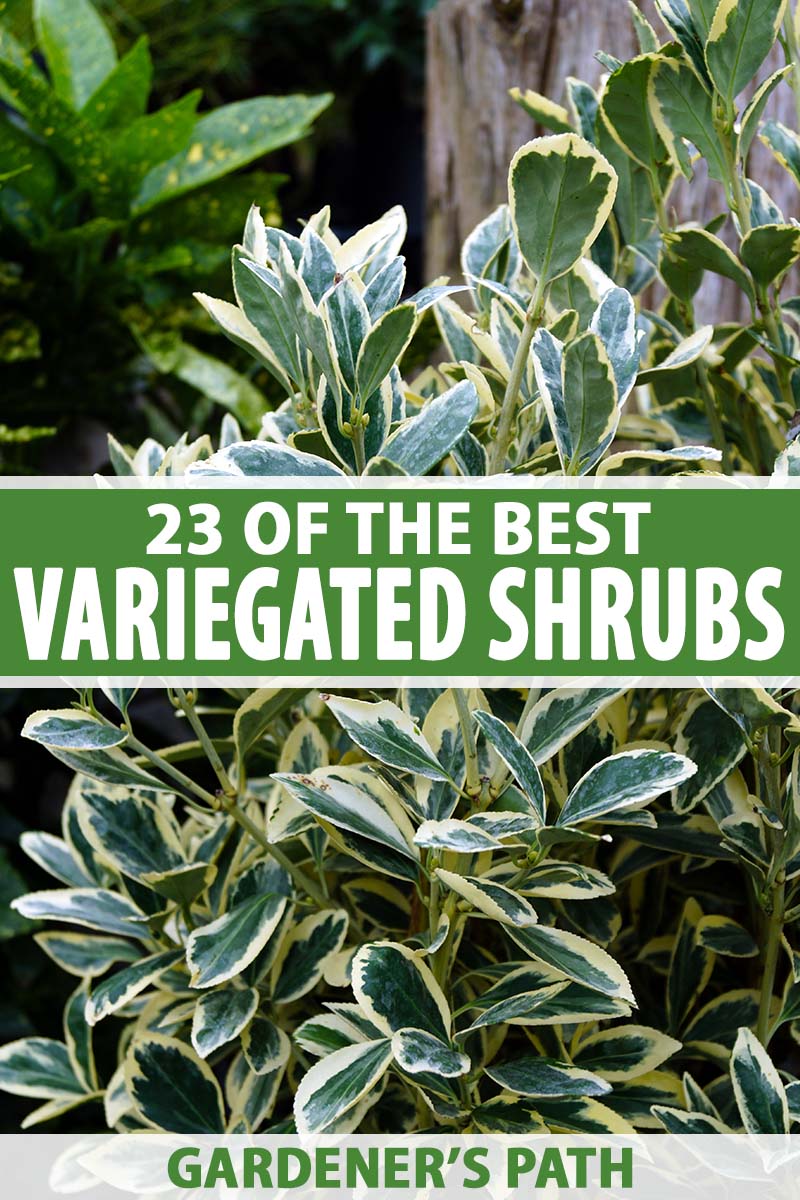
We link to vendors to help you find relevant products. If you buy from one of our links, we may earn a commission.
However, when they have eye-catching qualities, they suddenly pop into focus, increasing their garden value. A trait I particularly love is variegated leaves.
Foliage that is variegated has more than one color on each leaf. A pattern may be uniform, with all leaves the same, or random, with variation among the leaves.
Patterns include markings like streaking, blotching, spotting, and outlining in one or more colors. Sometimes they are a species’ natural tendency, but they can also be the result of rare genetic mutations.
When unusual coloration occurs, the presenting plant is called a “sport.” Thanks to the magic of plant breeding, sports can be reproduced and cross bred, for an ever-increasing array of shrubbery characteristics.
In this article, we bring you a roundup of 23 of our favorite variegated shrubs for the home garden.
23 of the Best Variegated Landscape Shrubs
With so many to choose from, I know you’re eager to get started, so here we go!
1. Abelia
Abelia x grandiflora ‘Kaleidoscope’ lives up to its name with lime green leaves edged in yellow that turn from bronze to orange and red hues as the growing season wears on.
It thrives in Zones 6 to 9 and is the longest blooming of all the Abelia species.
This compact bush tops out at 36 inches tall, and varies in width from 36 to 40 inches. It’s a semi-evergreen that keeps its leaves in the warmest regions.
Pink buds and white blossoms in spring, as well as red-hued stems, accent an already jubilant foliar display.
‘Kaleidoscope’ requires a full sun to part shade location. It tolerates poor soil, heat, and drought, and is not attractive to deer.
Pot it up, add it to a mixed bed, create a friendly low perimeter hedge, or create a massed drift as desired. Its modest size guarantees versatility in the garden.
Find ‘Kaleidoscope’ now in #5 containers from Nature Hills Nursery.
2. Azalea
Semi-evergreen Bollywood® ‘Farrow’ azalea has dark green foliage with irregular cream or silver margins. It’s suited to Zones 5 to 9.
A low-profile 18 to 24 inches high and 24 to 30 inches wide, this cheerful sweetheart is perfect for containers, beds, and borders.
It requires a full sun to part shade location, and benefits from winter shelter in the coldest regions, where it is likely to drop its leaves.
Be sure to choose a location that will be noticed by all, especially in springtime, when its magenta flowers burst into bloom.
Find Azalea Bollywood® ‘Farrow’ in quart containers available from Nature Hills Nursery.
Learn more about how to grow azaleas here.
3. Boxwood
Evergreen variegated boxwood, Buxus sempervirens ‘Variegata,’ is a new version of the old classic, with cream margins on dark green leaves.
It grows best in Zones 5 to 9, needs full sun to part shade, has above average heat and cold tolerance, and is deer resistant.
Mature heights are between five and eight feet, and widths range from five to six feet, providing ample material for sculpting into your wildest potted topiary dreams.
In the garden, try your hand at creating rectangular hedges or round ornamental specimens.
Find variegated boxwood cone-shaped topiaries now from Nature Hills Nursery in #5 containers.
Learn more about growing boxwood shrubs here.
4. Cape Jasmine
Cape jasmine, Gardenia jasminoides ‘Variegata,’ has glossy evergreen leaves randomly splotched with lime and dark green.

Its luscious white flowers bloom from spring into summer, scenting the garden with sweetness in Zones 8 to 11.
A compact, rounded form, and a mature height and width of three to four feet make it ideal for cultivation as a standalone specimen. Grow it in a pot or plant in the garden as desired.
5. Chinese Fringe Flower
Loropetalum chinense ‘Jazz Hands’ is a Chinese fringe flower with pink and white splotched foliage that matures to deep purple.
It is a semi-evergreen for Zones 7 to 9 that drops its leaves in the coldest climates.
A full sun to part shade location is required. Mature heights and widths range from four to six feet.
Springtime is party time, when bright pink flowers resembling tiny ribbons of crepe paper bloom.
Liven up drab areas of the garden with this exceptional and imposing form by using it alone or as a contrasting element with solid green shrubbery.
Find ‘Jazz Hands’ fringe flowers in two-gallon containers available from Home Depot.
If you want to add Chinese fringe flowers to your garden, check out our growing guide for full cultivation instructions.
6. Cotoneaster
Deciduous Cotoneaster horizontalis ‘Variegatus’ has small, glossy, rounded, dark green leaves with irregular white margins.
They shade dramatically to red and pink in the fall, when they are adorned with bright red berries.
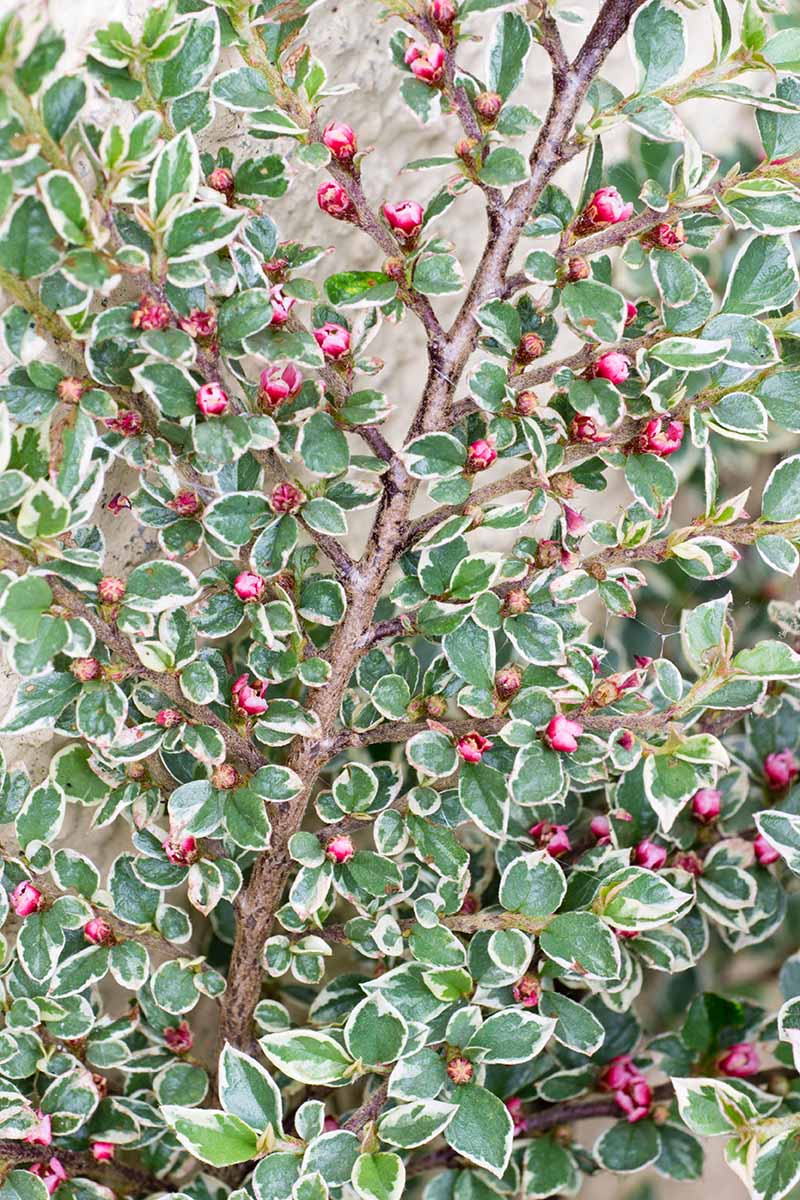
It requires a full sun to part shade location and does best in Zones 5 to 7.
The branching pattern is unique, in that lateral stems alternate and arch, bending to form more of a dense, mounded ground cover than an upright shrub.
In the spring, the foliage is dotted with pink blossoms.
Mature heights are up to three feet tall and wide. Salt and pollution are well tolerated, making this a sensible option for roadside placements that offers a measure of privacy without obstructing the view.
Read more about caring for cotoneaster here.
7. Dogwood
Cornus alba ‘Crmizam’ also known as Creme de Mint™ dogwood, is a cultivar of Siberian dogwood. It has light green deciduous leaves with cream margins, and thrives in Zones 3 to 8.
The name refers to its unique chartreuse stems.
In full sun to part shade, it grows to a compact four to five feet tall and wide, with an upright, rounded growth habit.
It tolerates salt and pollution, and is a striking ornamental specimen when planted in mixed groupings.
Seasonal accents include white blossoms in spring, and bluish-white berries in autumn.
Find Creme de Mint™ dogwood from Nature Hills Nursery in #3 containers.
8. Euonymus
Evergreen Euonymus fortunei ‘Moonshadow’ euonymus has red stems and contrasting glossy green leaves with irregular yellow margins.
The yellow deepens throughout the growing season, and shades to pink hues in fall.
Euonymus fortunei ‘Moonshadow’
Suited to Zones 5 to 10, ‘Moonshadow’ prefers full sun to part shade and is tolerant of a variety of soils.
It has petite dimensions of just one to two feet tall and wide. Creeping branches form an irregular, rounded shape with tremendous textural appeal.
An excellent filler in beds, borders, containers, and mixed groupings, it sets off yellow- and red-toned perennials to best advantage.
Find ‘Moonshadow’ plants in #1 containers available from Nature Hills Nursery.
Find tips on growing Euonymus shrubs here.
9. Gold-Edged Winter Daphne
Gold-edged winter daphne, Daphne odora ‘Aureomarginata,’ is an evergreen shrub with glossy, thick green leaves edged subtly in yellow. It grows in Zones 7 to 9, where it is appreciated for its winter hardiness.

Choose a location with part shade for best results. Expect mature heights of two to four feet and widths from three to four feet.
And as it lacks even the slightest hint of menacing thorns, gold-edged winter daphne’s cut stems are a welcome addition to holiday decor.
Mass plant in drifts and mixed groupings, or use as a standalone specimen.
Highly scented red-purple flowers bloom in late winter to early spring, and red berries herald the arrival of fall, providing bold pops of contrasting color.
Get more info on winter daphne care here.
10. Heavenly Bamboo
Evergreen Nandina domestica ‘Twilight’ is a multicolored version of a shrub commonly known as heavenly or sacred bamboo – however, it is not true bamboo.
It has medium to dark green leaves splashed with bright white, and grows in Zones 6 to 9.
This compact bush has a clumping form with mature dimensions of three to four feet tall and wide. Upright, slightly arching canes characterize its airy growth habit.
There may be nondescript white blossoms.
Cultivation is easy in both the garden and containers where there is full sun to part shade.
It’s relaxed form and varied pigmentation play well against more formal green shrubs in mixed groupings.
Find ‘Twilight’ plants now from Nature Hills Nursery.
Find tips on growing heavenly bamboo here.
11. Hebe
Hebe x andersonii ‘Variegata’, aka Anderson’s hebe, is an evergreen for Zones 7 to 10. It has glossy, gray-green leaves with irregular cream to white margins.
They are arranged in pairs, creating a telescoping appearance. With cool temperatures, the foliage can take on a purple hue.
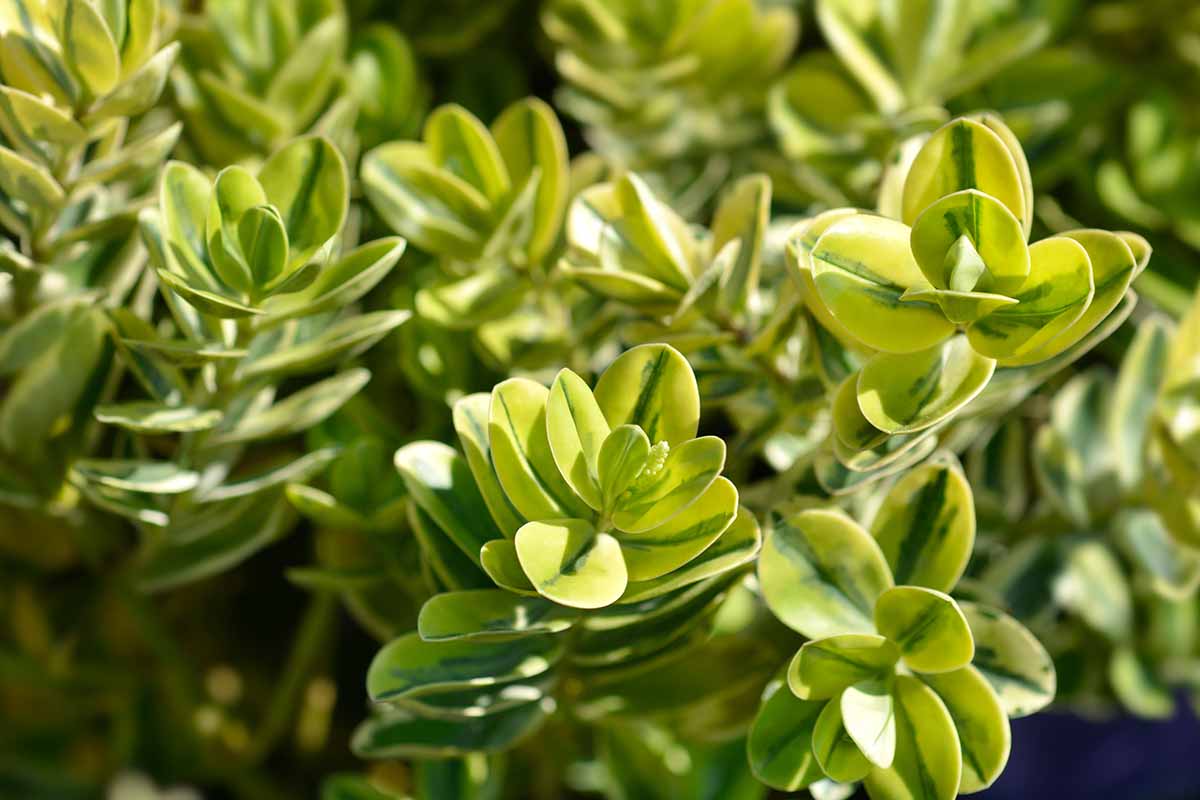
Above the colorful upright foliage, purple flowers cluster in terminal spikes that appear in summertime.
A full sun to part shade location is required. Mature dimensions are a modest two to three feet tall and wide. Show it off as a specimen in containers and mixed beds, or mass plant.
12. Hydrangea
Hydrangea macrophylla ‘Mariesii Variegata,’ a deciduous variegated lacecap hydrangea is a bigleaf variety for Zones 5 to 9 that has medium green leaves highlighted by irregular cream-colored margins.

Showy flattened flower heads are pink in alkaline soil and blue in acidic, and have a lacy edge of white blossoms around their edges, for a romantic cottage garden feel. They bloom in summer.
This shrub prefers a partially shaded location, and doesn’t do well with too much sun. It has a rounded, mounding growth habit.
Mature heights and widths reach four to five feet, a useful medium size for foundation plantings, mass groupings, mid-story placements, and stand-alone specimens.
Learn more about how to grow hydrangeas in this guide.
13. Japanese Laurel
Japanese Laurel, Aucuba japonica ‘Gold Dust,’ is an evergreen shrub that sports glossy, thick dark green leaves with yellow spots. It is best suited to Zones 7 to 10.
Unlike many plants that do best with some sun, this one requires a full shade location, and can actually scorch if it is exposed to too much light.
The overall shape is round and the foliage is dense. Mature dimensions are four to six feet tall and wide. Resistance to deer and drought tolerance are above average.
Best uses include shade gardens, foundation plantings, understory (beneath tree canopy) hedging, and mixed shrub groupings.
Find ‘Gold Dust’ now in 9.25-inch pots available at Home Depot.
14. Japanese Pittosporum
Pittosporum tobira ‘Variegatum’ is an evergreen for Zones 8 to 11. It has thick, glossy gray-green leaves with cream margins.
In the spring it bears clusters of small, fragrant white blossoms. As the season wears on, berry-like light green fruits open to reveal orange-red seeds within.
Pittosporum tobira ‘Variegatum’
This is a large, mounding shrub with mature heights of eight to 12 feet and widths of 12 to 18 feet.
Also known as mock orange, it’s waterwise and can withstand some drought. Exposure to salt and pollution are not a problem.
Best uses include mass plantings, hedging, and privacy screening. Prune as desired for tree-like potted ornamentals.
Find Japanese pittosporum plants in 2.5-gallon containers available from Home Depot.
15. Japanese Privet
Variegated Ligustrum japonicum ‘Variegatum’ is a twist on the typical privet, which we take for granted to be a dense and dependable hedge.
However, with the addition of a cream leaf margin, suddenly there’s depth and texture that beg for a second glance.
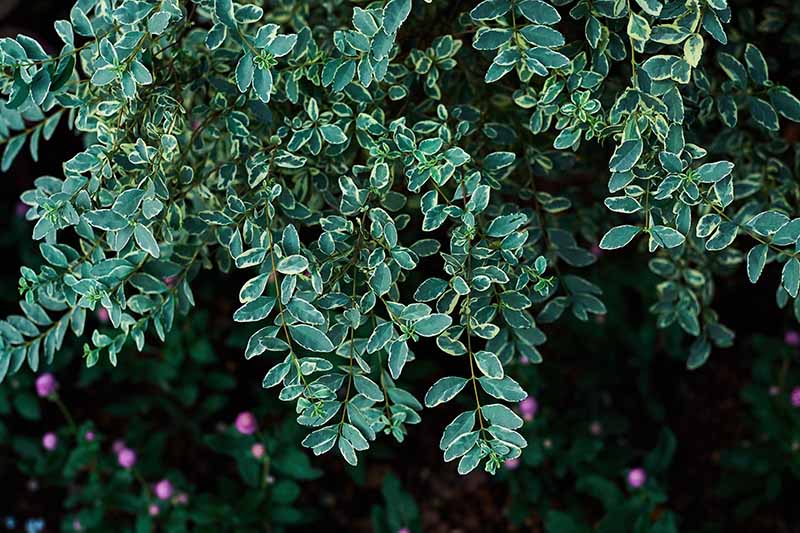
This is an evergreen that thrives in full sun in Zones 7 to 10. It can reach mature heights of 10 feet and widths of six feet, and can be pruned to dimensions of your choice.
Tiny white flowers bloom in spring.
A modern take on an old classic, the highlighted foliage offers a texturally rich backdrop to specimen plantings in a manicured landscape.
16. Leucothoe
Leucothoe fontanesiana ‘Rainbow’ is an evergreen with foliage splashed in cream, green, pink, and red, for an eclectic look in Zones 5 to 9.
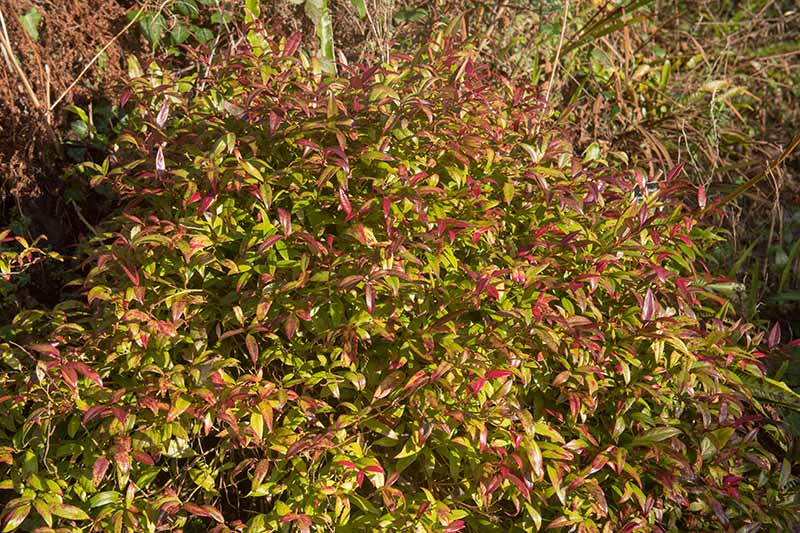
Red leaf petioles add to the cacophony of color, and in spring, pendant clusters of tiny white, bell-shaped blossoms grace the arching branches of this mounding bush.
‘Rainbow’ prefers shady locations with some sun, where it grows to a mature height and width of three to five feet.
Best uses include mass plantings in foundation and perimeter borders, as well as ornamental specimens.

You can find ‘Rainbow’ available from Green Promise Farms via Amazon.
17. Lilac
Variegated lilac, Syringa vulgaris ‘Aucubaefolia,’ has medium green leaves splashed with yellow, for an unexpected twist on this plant’s typical green foliage in Zones 3 to 7.
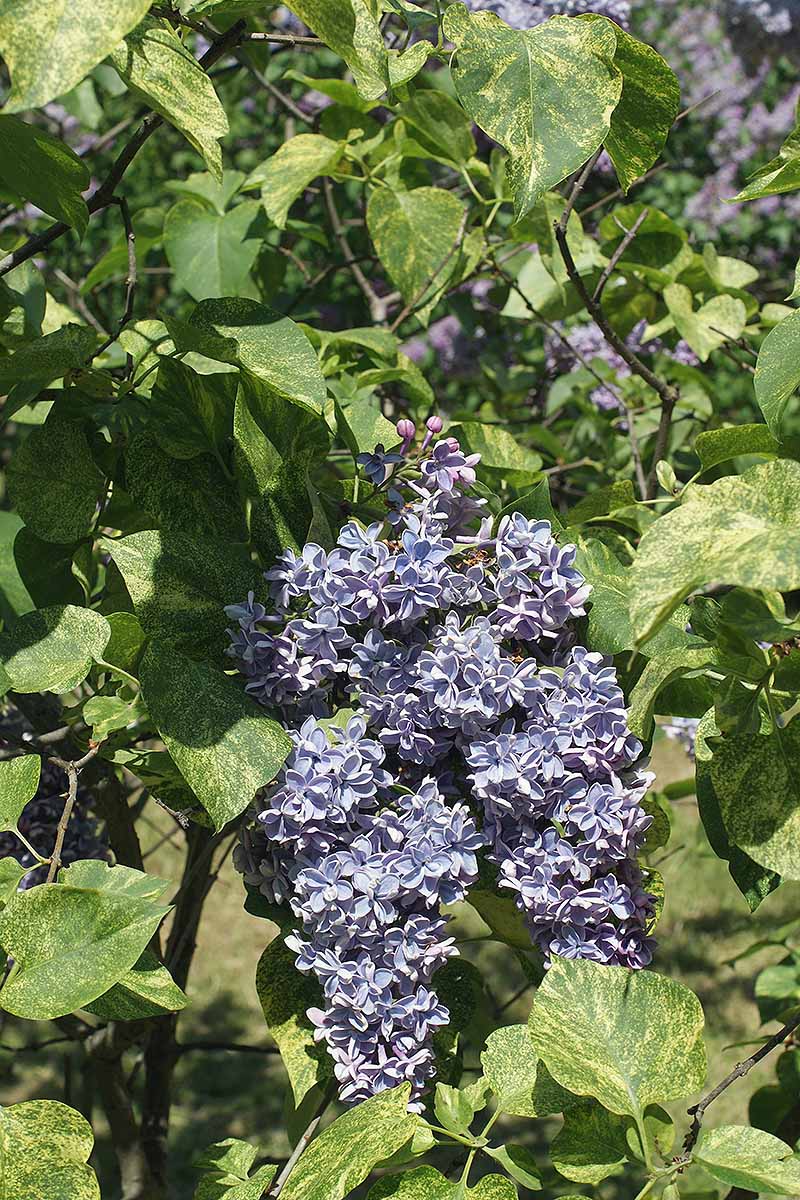
In spring, with its fragrant lavender-blue blossoms in full swing, it’s a heady attraction.
In full sun locations, it can reach a mature height and width of 10 feet, for a commanding presence.
Allow it to fill out, or prune it like a small tree. Plant en masse if you have the space, or as a standalone focal point.
You can learn more about how to grow lilacs in this guide.
18. Lily of the Valley Shrub
While pieris is an evergreen landscape staple, particularly in formal settings, the variegated variety, Pieris japonica ‘Variegata,’ is somewhat more playful and attention seeking with creamy white margins on its spear-shaped foliage.
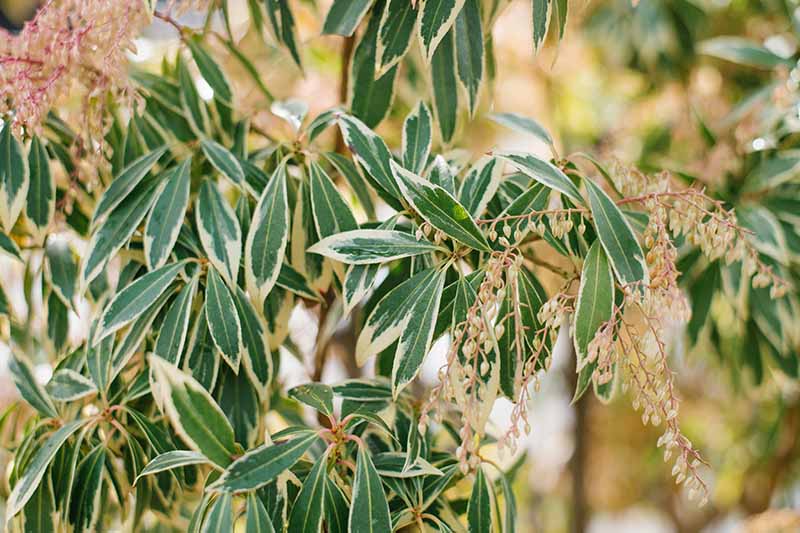
At home in full sun to part shade, it does best in Zones 6 to 9, where its compact height and width of three to five feet offer versatility.
Best uses include mass plantings, friendly hedges, and potted or garden focal specimens. Plants generally don’t appeal to foraging deer.
19. Oleander
Variegated oleander, Nerium oleander ‘Variegata,’ is a tropical evergreen that has spear-shaped medium green leaves with irregular cream-colored margins.
It grows in Zones 9 to 11, and has fragrant clusters of bright pink flowers from summer into fall.
This is an upright plant with a rounded shape that grows to impressive heights of 10 to 18 feet and widths of 10 to 15 feet. With artful pruning, you can shape it like a tree if desired.
Group several for privacy screening, or plant individually. Tolerance of drought, poor soil, and pollution are above average.
Find variegated oleander plants in two-gallon containers available from Home Depot.
Read more about growing oleander shrubs here.
20. Rose of Sharon
The deciduous white-tipped, blue-green foliage of rose of Sharon, Hibiscus syriacus ‘Sugar Tip,’ does indeed appear to have been dipped ever so slightly into confectioner’s sugar.
And to round out the confection, it has flouncy pink double-petal flowers that bloom in summer.
Best in locations with part sun in Zones 5 to 9. ‘Sugar Tip’ has mature heights of five to six feet, and a spread of four to six feet.
Use as a mid-story mass planting, privacy hedge, or specimen in mixed cottage garden beds.
You can find ‘Sugar Tip’ rose of Sharon starter plants available from Burpee.
Read more about growing rose of Sharon here.
21. Spirea
Spirea is a powerhouse in the landscape, and this variegated cultivar, Spiraea japonica Double Play ® Painted Lady® ‘Minspi,’ is no exception.
With vibrant foliage splashed by a euphoric artist in cream, yellow, and medium green, it never fails to dazzle in Zones 4 to 8.
And as if that weren’t enough, in addition to the foliar highlights, there are fuzzy magenta spring blooms for bright color and rich texture.
At home in full sun to part shade, it’s two- to three-foot height and width render it a top selection for gardening in small spaces. It is also noteworthy for its deer and drought resistance.
Find Double Play ® Painted Lady® ‘Minspi’ in one-gallon containers available from Home Depot.
Learn how to grow spirea in your garden here.
22. Weigela
Deciduous Weigela florida ‘My Monet’ has bright green leaves with irregular cream margins accented by pink.
It is especially attractive from spring into summer, when a profusion of trumpet-shaped pink flowers appears.
Perfect for full sun locations in Zones 4 to 6, it is a low-profile plant with mature heights and widths of 12 to 18 inches.
Best uses include beds, borders, and containers, both grouped and alone.
This plant is noteworthy for its deer resistance.
Find Weigela florida ‘My Monet’ plants in one-gallon containers available from Home Depot.
23. Yucca
Yucca filamentosa ‘Color Guard’ has vertical leaves with dark green margins and creamy yellow centers that are stemless and sword-like, for a bold structural statement.
It is a tropical evergreen for Zones 4 to 10.
Yucca filamentosa ‘Color Guard’
The foliage is approximately three feet tall with an equal spread. In summer, a stalk rises five feet or more, and produces a panicle of bell-shaped, cream-colored blossoms.
Resistant to cold, drought, heat, and humidity, as well as deer and rabbits, this is a hardy water-wise shrub that is appropriate for both xeriscaping and container gardening.
Find plants in one-quart containers available from Nature Hills Nursery.
Learn more about growing yucca plants here.
A Stylish Staple
As you can see, there are quite a few variegated shrubs.
As the mid-story workhorses of the garden, as well as standalone full size and compact specimens, their varied hues are sure to increase the visual appeal of your landscape.
When shopping for bushes with an array of leaf coloration, you may find testaments to their “stability.” Take this with a grain of salt, as the cultivated “sports” we discussed at the beginning of this article, may undergo “reversion.”
This is a process of regressing back to the traits of the original parent plant.
What does this mean for you?
One day, you may find a stem with leaves that look nothing like the rest of the bush. They are most likely solid green. This a throwback to the parent plant that produced the original sport.
Solid green leaves have more chlorophyll than multicolored ones, so they are likely to grow faster than the rest.
To prevent them from becoming dominant, you’ll need to prune off all non-variegated stems at their points of origin.
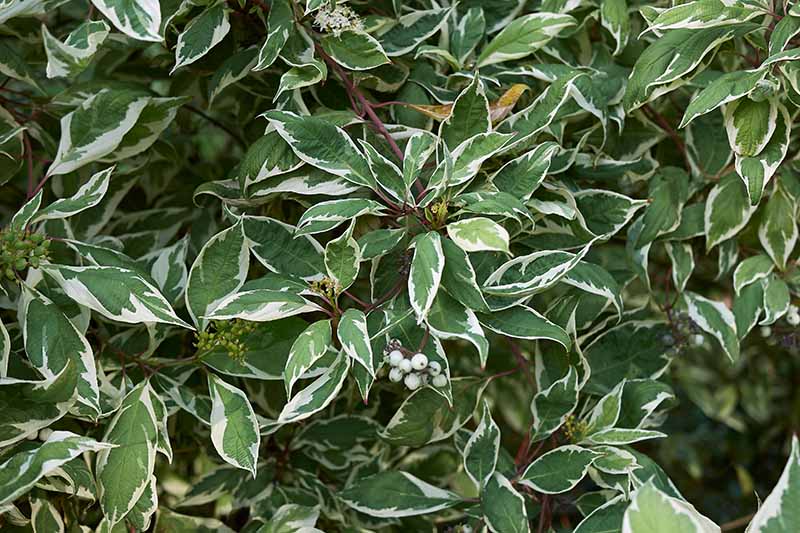
My euonymus does this occasionally. With regular monitoring, I have been able to remove the solid green leaf stems and retain the variegation of the foliage.
Now it’s time to choose your favorites!
Be sure to note the sun requirements of each, as the proper amount of light contributes to their most vivid coloration.
Get out your garden planner today and add variegated shrubs to your list. They’re a stylish version of a landscape staple you’re sure to love.
What variegated shrubs grow in your garden? Have you dealt with reversion? Please tell us in the comment section below, and feel free to share a picture!
And for more information about growing shrubs in your garden, check out these guides next:
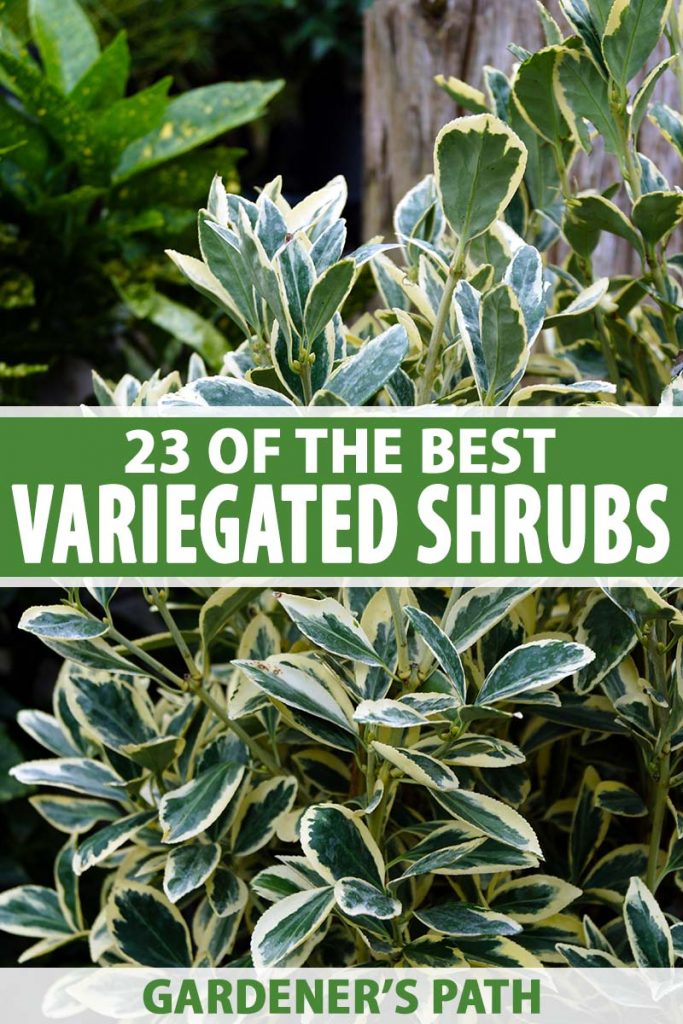
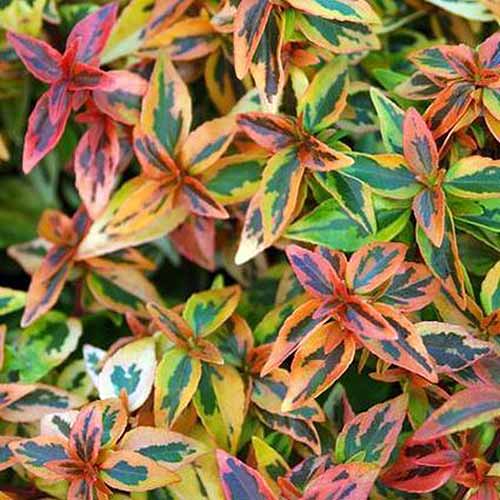
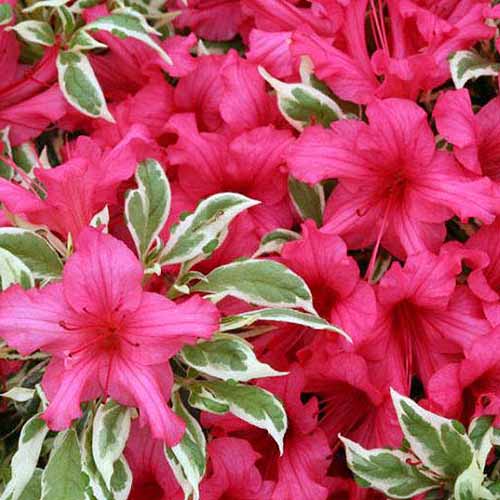
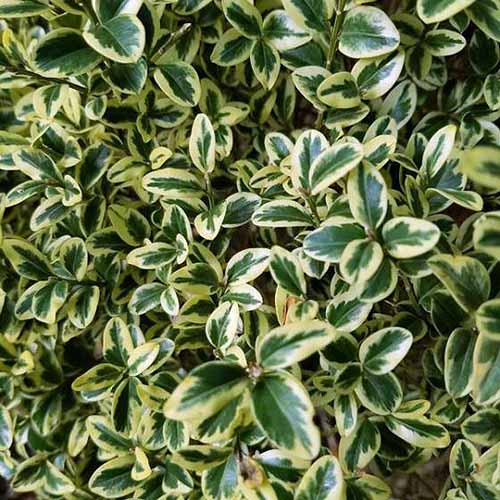
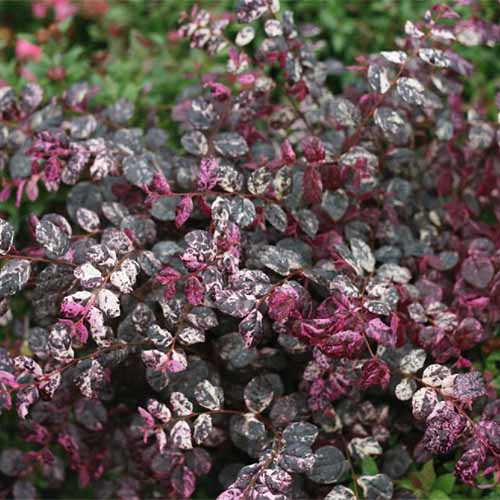



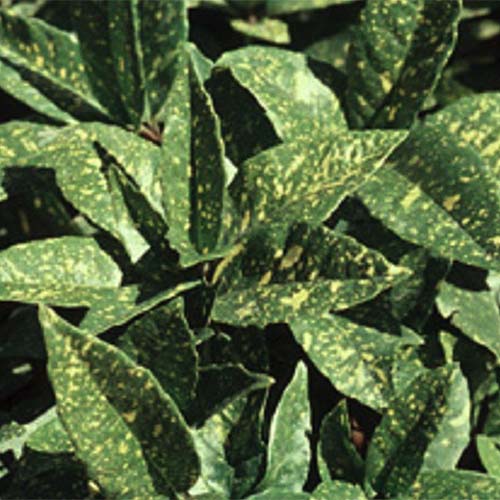
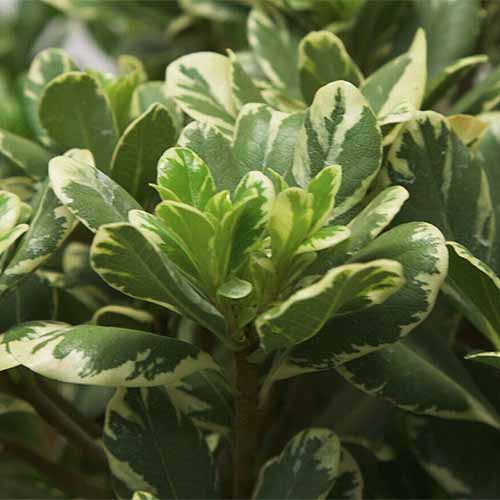
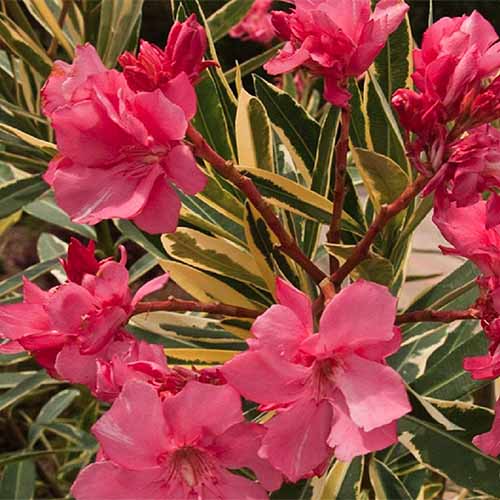
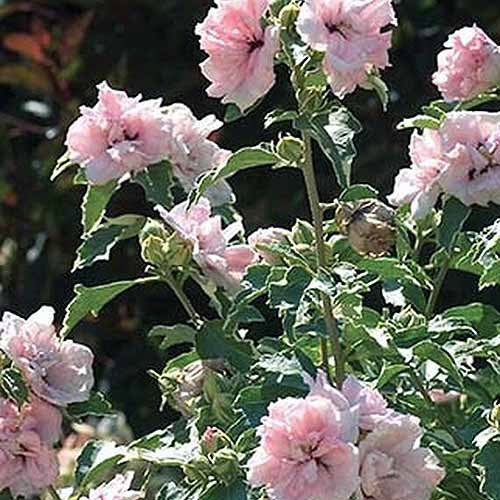
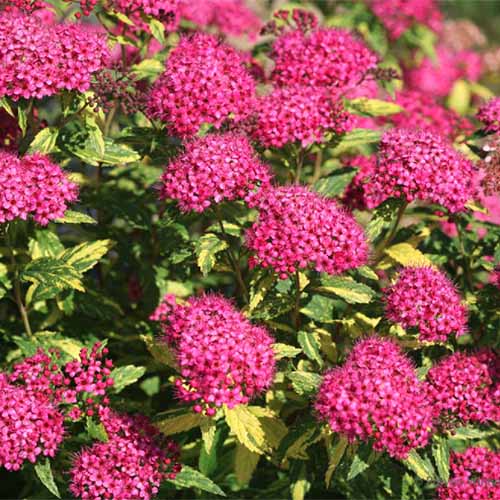


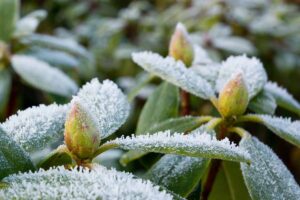
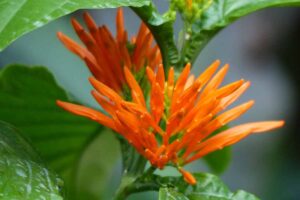
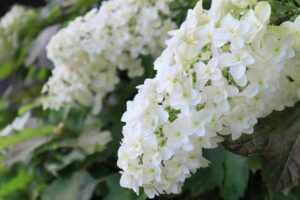
What is the type of plant that is used for the title page image? It is not noted.
Hello Kat –
The variegated shrub in the title photo is Euonymus fortunei ‘Silver Queen’.
What is the name of the bush in the very last photo, where pruning is discussed?
This is Cornus alba ‘Elegantissima,’ a variety of tatarian dogwood.
I planted a bush 2 years ago that I just dug up and moved in my back corner of the yard. It has variegated leaves that have ridges and white spires that grow in the summer. I didn’t know that it was going to send out runners that would pop up all over my flower bed. Too aggressive! I have been trying to find out it’s name to no avail.
Hi Jaynee –
If you’d like to submit photos, we’ll do our best to help you identify these aggressive shrubs. Or, you can contact your local agricultural extension for assistance.
Thanks. I came here to look for the name of the flower Cape jasmine, Gardenia jasminoides ‘Variegata,’. Malaysians call it as Japanese Rose
I’m totally in love with variegated shrubs.
Hello, This a good article. Would you please suggest what cloves you recommend that relatively completely protect your hard when handling these? Also, I am in Oregon, and I’m curious what plans would you recommend to provide a barrier against cats walking into my property, and Also, that would be appropriate to provide some kind of a barrier from people picking into my windows, but from the other perspective that I could see through, like rose stems, and identify if there is someone standing? So in essence, you could see through from the inside of a house, but hard to… Read more »
Hi Sam –
For gloves, I refer you to our article, “17 of the Best Gardening Gloves in 2023.”
To deter cats, you might try perennial lavender.
And witch hazel is an airy shrub that is not too dense to block your view, but dense enough to form a visual barrier between your windows and passersby. Selective pruning can help to achieve the desired effect.
Looking for ideas
You’ve come to the right place!
Wondering what this might be? Not a boxwood as the leaf edges are serrated not smooth.
Hi Donna –
You have a variegated variety of Euonymous fortunei, aka wintercreeper. It’s a non-native, semi-evergreen perennial vine introduced to the United States as an ornamental species in the early 1900s.
It is highly invasive, forming a thick ground cover, creeping up trees, and killing native flora in its path.
It’s best to remove wintercreeper from the landscape.